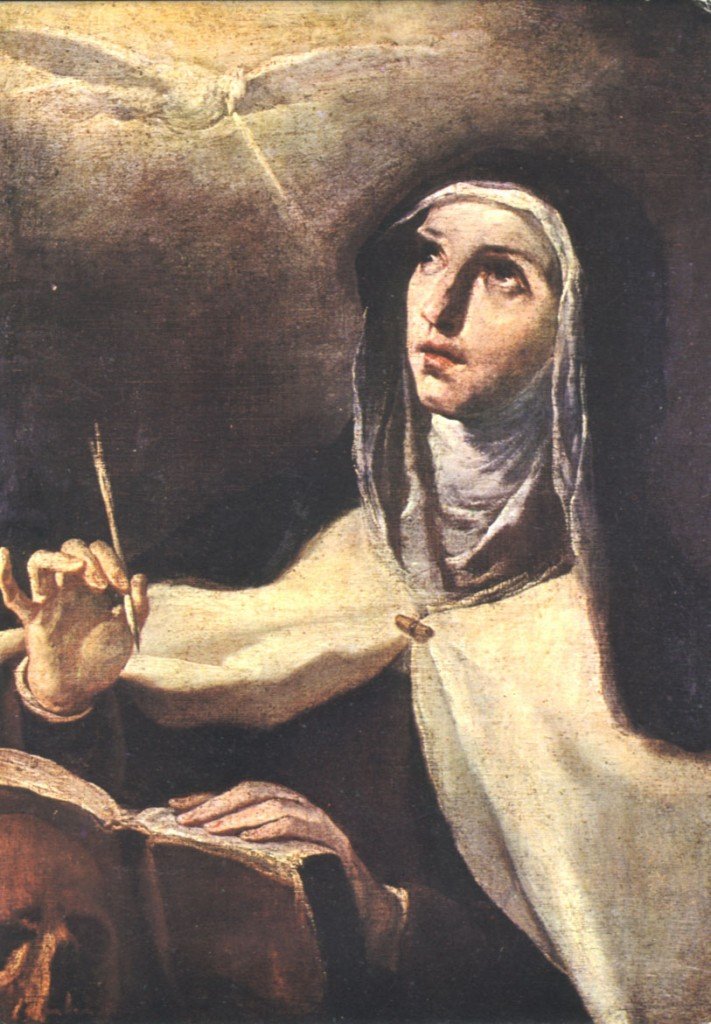I noticed this past week that St. Teresa of Avila (1515-1582, October 15th) and St. Margaret Mary Alacoque (1647-1690, October 16th), were back-to-back on the Catholic liturgical calendar. As I pondered whether either of them might be a good topic for one of my periodic saint reflections, I began to wonder what they might have in common.
At first glance, not much. Teresa, one of the most famous and consequential saints in history, was a Spanish Carmelite nun who rose from mediocrity to become one of the foremost guides to contemplative prayer in the history of the Church. Margaret Mary, a much lesser-known French nun from a century later, did not have the initial impact that Teresa did. However, one thing they did share was the experience of extraordinary visions which, in different ways, had enormous influence in the centuries since.
Teresa grew up as a fairly pious girl and eventually decided to become a nun. This was quite common in her day. Life in a convent could be a pleasant alternative to marriage, and some convents were more lax and easy-going than others. Teresa chose a nearby Carmelite convent known for being easy-going. A soft, pious life beckoned. The Carmelites had been founded during the Crusades, near Mount Carmel in Palestine, as an order of contemplative, praying monks. It spread throughout Europe and, but, as often is the case, lost some of its fervor as centuries passed. Teresa was a good nun, but not a great one. She had a genuine faith, but dealt with intermittent sickness and an attraction to an active social life. After all, she was vivacious, bright, and pretty. Yet beyond the social life, she did pray and seek God in ordinary ways – like many of us. She read a translation of St. Augustine’s Confessions, and this helped her overcome a problem with scruples, with worrying about God’s love and forgiveness.
As Teresa approached forty, she began to have visions. She would see Jesus and angels and hear voices exhorting her to holiness. These troubled her. Were they real? Were they from God? She did not know. The visions persisted. Teresa had spiritual guides and confessors. One was Francis Borgia, a Jesuit priest from an illustrious family who had raised a family with his now deceased wife. Borgia, also a canonized saint, went on to become one of the greatest leaders of the Jesuits. Upon prayer and discernment, he gave Teresa advice that turned out to be crucial for her and for Church history: yes, her visions do indeed appear to be from God. That sent Teresa out on her calling as a reformer and expert on prayer.
Teresa’s life changed. She embarked on a path toward holiness, prayer, asceticism, and teaching for the rest of her life. She and fellow Carmelite St. John of the Cross, set out to reform the Spanish Carmelite houses, men’s and women’s, to remove the laxity and point them toward a profound and renewed commitment to God in the Carmelite tradition. They succeeded but not without monumental pushback and persecution from those invested in the status quo. Their success at renewing the Carmelites bore fruit throughout the Catholic world for centuries through today, inspiring, for example, St. Therese of Lisieux, the beloved French Carmelite nun of the late 19th century. She would refer to Teresa as her mother.
It was Teresa’s writings that have created her lasting legacy. In her Interior Castle, Life, and Way of Perfection, Teresa describes from her experience and her visions, a way of communion with God in prayer that has assisted thousands to this day. Yet, despite the deep and seemingly unattainable paths she describes, she is actually practical. As she put it in her Life, mental prayer is “nothing else than an intimate sharing between friends; it means taking time frequently to be alone with Him who we know loves us.” (Life, Ch. 8,5)
One thing about Teresa that inspires me is that fact that she started out as an ordinary Christian, very much like many of us. A good deal of saint stories are either of rags to riches conversions (St. Augustine, St. Francis) or of people unusually devout from the beginning (St. John Vianney, St. Therese of Lisieux). Teresa of Avila was good, but ordinary. There is hope for us.
Margaret Mary also was an ordinary girl, but much more devout from the beginning than Teresa. She also became a nun, joining a convent of the Visitation order. It was a struggle for her to be admitted due to health concerns and a perceived lack of skills to contribute, but eventually she was accepted. Soon, she, too, began to have visions.
In her visions, Christ appeared to her, asking for a new devotion that would focus believers on the depth of his mercy and love. Margaret Mary confided her visions and Christ’s instruction to her superiors and initially met great resistance. It took multiple investigations before Church authorities, ever careful, acknowledged that her visions were authentic. The image of mercy and love that Christ conveyed to her was of his heart, and from this originated the Church’s Feast of the Sacred Heart, celebrated each June, and First Friday devotions with reception of the Eucharist. These devotions have spread into the heart of the Church over the last 300 years.
What do Teresa’s and Margaret Mary’s visions tell us? I have one overriding take from them: there is a God. Church authorities, who in no way want the Church to have egg on its face, thoroughly vet reported visions for authenticity and fruit. Most are rejected as inauthentic or not of God. Some, such as these, are deemed to be supernatural events of divine origin. Knowing of authentic supernatural events can break through our daily strains and temptations which fog our minds from the divine, and point to the existence of the divine. Indeed, at times God does break into this world supernaturally to remind us that he is there. And he does so with a message, usually of his love and mercy or of the dire need for prayer and conversion, often both at the same time.
The experiences of these two women can offer us encouragement and hope, and perhaps even motivate us to get going about our own vocation to strive toward holiness and to pray for others.
May the lives of these two remarkable women be an inspiration for us.



1 Comment
When I did my saint report on Teresa of Avila in 7th grade, I noted that she died on Oct. 4 and her feast day is Oct. 15, which was the day immediately following her death. I don’t remember the details but there was some kind of official calendar shift scheduled for the day after she died. That’s the main thing I remember from that saint report, so thanks for sharing some of the more important parts of her story!
Add Comment